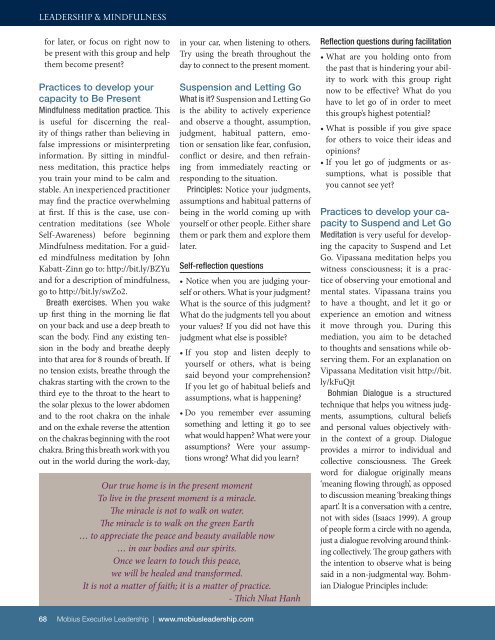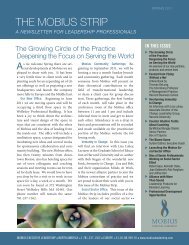Leadership & Mindfulness - Mobius Executive Leadership
Leadership & Mindfulness - Mobius Executive Leadership
Leadership & Mindfulness - Mobius Executive Leadership
You also want an ePaper? Increase the reach of your titles
YUMPU automatically turns print PDFs into web optimized ePapers that Google loves.
LEADERSHIP & <strong>Mindfulness</strong>for later, or focus on right now tobe present with this group and helpthem become present?Practices to develop yourcapacity to Be Present<strong>Mindfulness</strong> meditation practice. Thisis useful for discerning the realityof things rather than believing infalse impressions or misinterpretinginformation. By sitting in mindfulnessmeditation, this practice helpsyou train your mind to be calm andstable. An inexperienced practitionermay find the practice overwhelmingat first. If this is the case, use concentrationmeditations (see WholeSelf-Awareness) before beginning<strong>Mindfulness</strong> meditation. For a guidedmindfulness meditation by JohnKabatt-Zinn go to: http://bit.ly/BZYuand for a description of mindfulness,go to http://bit.ly/swZo2.Breath exercises. When you wakeup first thing in the morning lie flaton your back and use a deep breath toscan the body. Find any existing tensionin the body and breathe deeplyinto that area for 8 rounds of breath. Ifno tension exists, breathe through thechakras starting with the crown to thethird eye to the throat to the heart tothe solar plexus to the lower abdomenand to the root chakra on the inhaleand on the exhale reverse the attentionon the chakras beginning with the rootchakra. Bring this breath work with youout in the world during the work-day,in your car, when listening to others.Try using the breath throughout theday to connect to the present moment.Suspension and Letting GoWhat is it? Suspension and Letting Gois the ability to actively experienceand observe a thought, assumption,judgment, habitual pattern, emotionor sensation like fear, confusion,conflict or desire, and then refrainingfrom immediately reacting orresponding to the situation.Principles: Notice your judgments,assumptions and habitual patterns ofbeing in the world coming up withyourself or other people. Either sharethem or park them and explore themlater.Self-reflection questions• Notice when you are judging yourselfor others. What is your judgment?What is the source of this judgment?What do the judgments tell you aboutyour values? If you did not have thisjudgment what else is possible?• If you stop and listen deeply toyourself or others, what is beingsaid beyond your comprehension?If you let go of habitual beliefs andassumptions, what is happening?• Do you remember ever assumingsomething and letting it go to seewhat would happen? What were yourassumptions? Were your assumptionswrong? What did you learn?Our true home is in the present momentTo live in the present moment is a miracle.The miracle is not to walk on water.The miracle is to walk on the green Earth… to appreciate the peace and beauty available now… in our bodies and our spirits.Once we learn to touch this peace,we will be healed and transformed.It is not a matter of faith; it is a matter of practice.- Thich Nhat HanhReflection questions during facilitation• What are you holding onto fromthe past that is hindering your abilityto work with this group rightnow to be effective? What do youhave to let go of in order to meetthis group’s highest potential?• What is possible if you give spacefor others to voice their ideas andopinions?• If you let go of judgments or assumptions,what is possible thatyou cannot see yet?Practices to develop your capacityto Suspend and Let GoMeditation is very useful for developingthe capacity to Suspend and LetGo. Vipassana meditation helps youwitness consciousness; it is a practiceof observing your emotional andmental states. Vipassana trains youto have a thought, and let it go orexperience an emotion and witnessit move through you. During thismediation, you aim to be detachedto thoughts and sensations while observingthem. For an explanation onVipassana Meditation visit http://bit.ly/kFuQjtBohmian Dialogue is a structuredtechnique that helps you witness judgments,assumptions, cultural beliefsand personal values objectively withinthe context of a group. Dialogueprovides a mirror to individual andcollective consciousness. The Greekword for dialogue originally means‘meaning flowing through’, as opposedto discussion meaning ‘breaking thingsapart’. It is a conversation with a centre,not with sides (Isaacs 1999). A groupof people form a circle with no agenda,just a dialogue revolving around thinkingcollectively. The group gathers withthe intention to observe what is beingsaid in a non-judgmental way. BohmianDialogue Principles include:68 <strong>Mobius</strong> <strong>Executive</strong> <strong>Leadership</strong> | www.mobiusleadership.com



